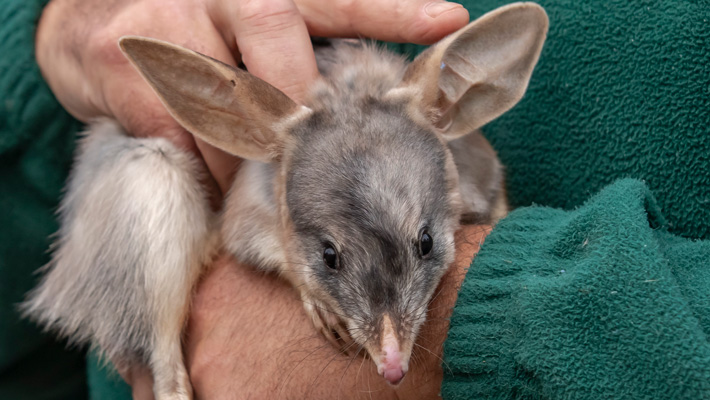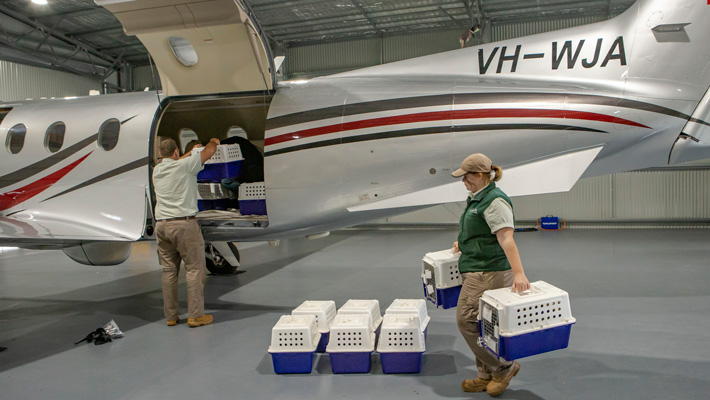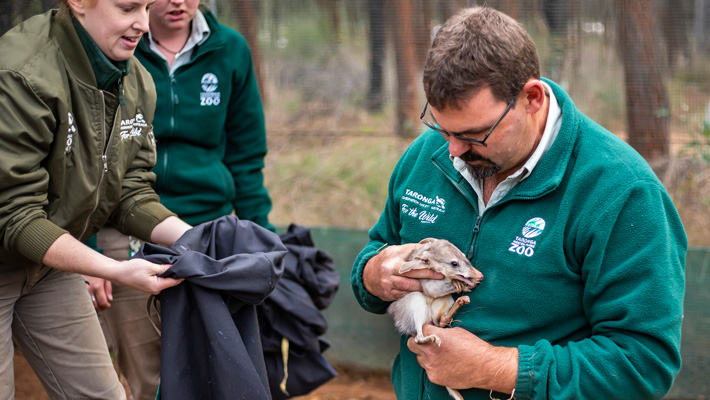Posted on 30th May 2022 by Media Relations
Australia’s threatened Greater Bilby reintroduced to Central Australian sanctuary
Australia’s iconic Greater Bilby is bouncing and digging around Australian Wildlife Conservancy’s Newhaven Wildlife Sanctuary near Alice Springs thanks to a national collaboration with Taronga Conservation Society Australia which has seen an important reintroduction of the species to a 9,450-hectare feral predator-free area at the sanctuary.
Thirty-two founders (18 males and 14 females) were specially selected from Taronga Western Plains Zoo in Dubbo this week, where a breeding program is underway to support rewilding projects like the one at Newhaven.
The individuals were carefully placed into travel carriers before being transported by charter flight to Newhaven, which is about 300 kilometres north-west of Alice Springs.



On arrival at Newhaven, the small jetsetters were subject to health checks and some of them were fitted with tail-mounted VHF transmitters which will enable AWC ecologists to track their movements as they settle into their new home. They were then released into the sanctuary’s 9,450-hectare feral-predator free area – one of Australia’s largest fenced safe havens.
Known to local Warlpiri people as ‘ninu’, the Greater Bilby is culturally significant to the Traditional Owners of Newhaven, and is an important ecosystem engineer that facilitates key ecosystem processes through burrowing and digging for food. Although once widespread across Central Australia, their numbers have drastically declined, due to the threats posed by feral predators such as feral cats and foxes, and destructive fire regimes in recent decades.
Kirsten Skinner, AWC Wildlife Ecologist, welcomed the bilbies back to Central Australia, saying their return will help secure the future of the threatened species.
“The Greater Bilby is the fourth mammal species reintroduced to Newhaven since 2017 and marks a significant milestone for AWC,” explained Kirsten. “These small creatures have a significant impact on the Australian landscape with a single individual capable of turning over 20 tonnes of topsoil per year.
“Their digging improves germination conditions for plants and helps maintain healthy soil dynamics. Signs of the species’ return to Newhaven were evident in the days following their release with burrows and diggings popping up all over the feral predator-free fenced area. “They play a critical role in the function of desert ecosystems and they’re already out there working hard.”
Sending the Greater Bilbies off to Newhaven was a celebratory moment for the team at Taronga Conservation Society Australia, who were excited to help establish an additional population of the species and increase the threatened species’ national numbers.
Taronga Conservation Society Australia CEO Cam Kerr AO said: “We are absolutely thrilled to release over thirty Greater Bilbies from our conservation powerhouse, the Taronga Sanctuary at Taronga Western Plains Zoo in Dubbo, to AWC’s Newhaven Wildlife Sanctuary in the Northern Territory.
“This is Taronga’s second release of this incredible Australian marsupial back to the wild and we are so proud of the collaborative conservation effort to get Greater Bilbies back onto the country where they were once found.”
The Greater Bilby population is estimated at fewer than 10,000 individuals. While once widespread across much of arid Australia, the Greater Bilby population crashed following European colonisation, and continues to suffer due to introduced predators such as feral cats and foxes.